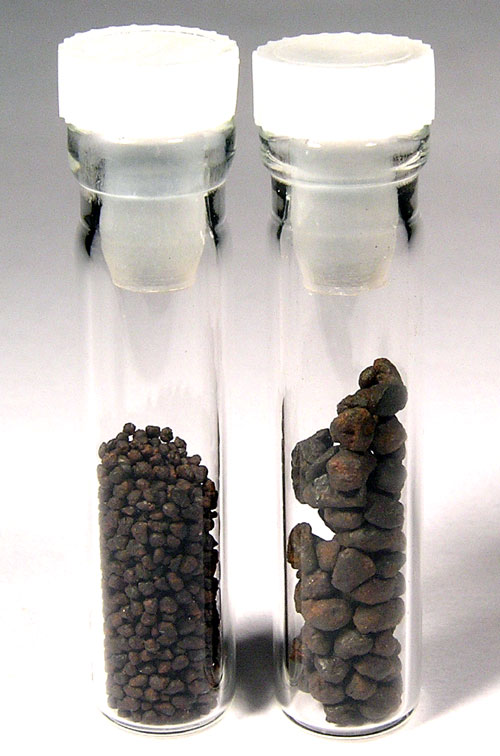


- Meteorites For Sale - Found A Meteorite? - Monthly Favourite - Meteorite Information - Classification List - Meteorite Collection - Media Centre - Home - Search - Site Map - Contact |
|
Harvey Nininger Canyon Diablo Metallic Spheroids Canyon Diablo Metallic Spheroids are found in the soil surrounding the famous Meteor Crater in Arizona. When the large body that created the famous Meteor Crater impacted, the majority of it vaporized. This created a huge cloud of hot Iron/Nickel vapour and as the cloud cooled, the iron started to condense and fall from the sky as an Iron/Nickel rain. The ground within about 8 kilometres of the crater contains a huge quantity of these droplets but they are very difficult to separate out. The spheroids below were originally collected by Harvey Nininger and are part of the Meteorites Australia Collection (0.4mm diameter - MA.02.0131 and 1.4mm diameter MA.02.0132). Dr. Harvey H. Nininger realised that these spheroids probably represented the missing main mass of the Canyon Diablo meteorite that others had believed would still be found buried deep within the crater. Nininger talks about the spheroids in his 1972 book; “Find A Falling Star” of which some is excerpted below. Find A Falling Star (1972), Harvey H. Nininger, Chapter 11 - Discovery (pp175-187) "During the frequent meteorite-hunting excursions that Addie, Margaret and I made in the summer of 1946, my interest turned more to the dust and small particles of sand grain-size that continually collected on our magnets. Back at the trailer below Mt. Elden I spent many hours going over these small particles which en masse always gave a strong chemical reaction for nickel. I suspected during that summer that I was finding the condensation products which Merrill had declared were lacking and which the Moulton explosion-theory seemed to require for its verification, but our trailer facilities were not adequate for the complete examination which the several types of material that we were collecting required. In the sorting of fragments gathered during the magnetic rake survey of 1939 we had discarded all material that would pass an eight-mesh screen. As we sifted out and cast away this great bulk of fine particles, I had begun to wonder whether perhaps we were culling the most important part of our harvest, and so I had bagged up a goodly sample of the discard for laboratory study and carried it back to Denver, but I had not got around to examining it. The greatest keys to my evolving theory about the crater were found in my boxes of soil samples. I was beginning to be certain that neither I nor anyone else had given to the soil in the environs of the crater the careful attention deserved, and when I turned my attention to the small particles of various descriptions that crowded the soil, the most exciting avenues of exploration and speculation were opened. The metal-center pellets made up but a small part of the magnetics gathered. At least a hundred particles must have been tested, individually, before finally, when one more particle was dissolved and subjected to the dimethylglyoxime test, a beautiful strawberry red appeared in the test tube. Surprisingly, the nickel-bearing particle was neither round nor black, as I had expected; it was brown and had a somewhat lumpy surface, though it tended toward the spherical in shape. Once we had learned how to recognize these and separate them from the several other kinds of magnetic particles, we took hundreds of samples on all sides of the crater and found that these metallic droplets were whole present in the top soil to an extent that projected to thousands of tons! Here, then, was the proof of Dr. Moulton’s explosion theory. I could think of no other way to account for these little droplets, two and a half times as rich in nickel as similar sized irregular fragments, than that they were condensation droplets from a meteoritic cloud produced by the explosion which Moulton had hypothesized. I named these droplets metallic spheroids. The survival of these tiny bits of pure metal was exciting. The spheroids, so tiny that 280,000 of them would weigh an ounce, were found as far from the crater as five miles. At that distance they were distributed at a rate of a few hundred pounds to the square mile; close to the crater rim the concentration was on the order of a thousand tons per square mile. We measured the quantity of spheroids in sixty different locations on state lands and estimated that from 4,000 to 8,000 tons must be present in the upper four inches of soil within an average radius of two and one-half miles from the crater rim. By projection, taking into account the processes of weathering, it is not unreasonable to estimate that the original deposit totaled as much as 100,000 to 200,000 tons."
Back to 'The Unusual Meteorites Features Page' menu...
|

-500.jpg)